
Best For
- Extremely fast material response time
- Excellent edge support
- 13″ thickness, good for high-profile
Considerations
- Poor pressure relief on the firm version, not recommended for side sleepers
- Moderate levels of motion transfer
- Struggles with heat retention, poor cooling performance
Our Verdict
The Sealy Posturepedic Hybrid mattress is a 13″ hybrid that uses a blend of poly foam comfort materials combined with a coil support unit.
This mattress is available in two firmness levels—soft and firm. The firm version has a firmness of 8 out of 10 and the soft version is estimated to be a 5 out of 10, where 10 is the most firm.
We tested the firm version, which has very minimal sinkage and a moderate level of bounce. If you’re looking for a deeper contour (or are a lightweight sleeper), the soft version would likely be better suited to you.
In our performance tests, the Posturepedic Hybrid did not impress, scoring in the bottom 3% of all hybrids tested to date. In our tests we found it to be notably warm, with poor pressure relief and less than great motion transfer.
Although the price is lower than the average, there are still many alternative hybrids under $800 on the market that offer better performance than Sealy.
Type: Hybrid
Firmness: Medium (5) or Firm (8)
Best For: Soft Version – Side Sleepers Firm Version – Back or Stomach Sleepers
In This Review
Performance Tests | Firmness | Support & Sleeping Positions | Design | Materials | Comparisons | FAQs
Performance Tests
At NapLab, we put each mattress to the test.
We test 10 different factors that impact the performance, comfort, and value of the mattress. Testing categories include:
| Factor | Sealy Posturepedic Hybrid | Average |
|---|---|---|
| Overall Score | 7.22 | 8.55 |
| Price (Queen) | $799 | $1,332 (Hybrid only) |
| Cooling – Score | 7.0 | 8.7 |
| Sinkage – Depth | 1.66″ | 2.14″ |
| Sinkage – Feel | Very Minimal | Moderate |
| Motion Transfer – Score | 7.2 | 8.2 |
| Motion Transfer – Acceleration | 11.15 m/s² | 8.78 m/s² |
| Response Time – Score | 10 | 8.9 |
| Response Time – Mostly Recovered | 0.2 sec. | 0.4 sec. |
| Response Time – Fully Recovered | 0.3 sec. | 0.9 sec. |
| Bounce – Height | 9.60″ | 9.54″ |
| Bounce – Feel | Moderate | Moderate |
| Edge Support – Score | 9.1 | 8.6 |
| Edge Support – Sitting | 3.75″ | 4.03″ |
| Edge Support – Lying | Excellent | Good |
| Sex – Score | 8.4 | 8.5 |
| Pressure Relief – Score | 5.0 | 8.7 |
| Comfort Layer Thickness | 4.0″ | 4.1″ |
| Mattress Thickness | 13″ | 12.0″ |
| Off-Gassing – Score | 6.9 | 8.1 |
| Off-Gassing – Smell | Strong | Strong |
| Off-Gassing – Days | 11 days | 7 days |
| Company – Score | 6.4 | 8.8 |
| Trial | 90 nights | 178 nights |
| Warranty | 10 years | 25% have lifetime warranties, average of other 75% of mattresses is 13 years |
How is Sealy Posturepedic Hybrid Different?
The Sealy Posturepedic Hybrid has an overall performance that is significantly lower than the average, paired with a price that is also below average—34% less than the average hybrid.
Besides for price alone, I find it hard to recommend this mattress. There are simply numerous other high-performing hybrids at this price point.
Advantages
It does have a fast material response time and good edge support. It is also 13″ thick, which is 1.0″ thicker than average. This thicker profile would usually be advantageous for pressure relief, but unfortunately, that’s not what we saw on this mattress.
In the case of the Posturepedic Hybrid, many more factors are working against this mattress than working for it.
Neutral Factors
Neutral factors include sinkage and bounce. Within a reasonable range, these factors are not really pros vs. cons, but rather a basis of personal preference.
This mattress has less sinkage than the average mattress and bounce levels that are about at the average level.
Disadvantages
The Posturepedic Hybrid has worse than average cooling performance, high levels of motion transfer, a long off-gassing period, and a shorter than average trial period.

Cooling Test
The Sealy Posturepedic Hybrid has fair, but far from good cooling performance.
In our tests, I felt a moderate level of heat retention around my body. On the positive side, it’s a hybrid, so the mattress has more airflow relative to an all-foam mattress. However, the hybrid design is the only notable cooling advantage.
Baseline Temp.
76.0° F
Max Temp.
89.4° F
Ending Temp.
81.1° F
The mattress is topped with low-quality foams that do this mattress no favors when it comes to heat retention.
Max Temp.

Ending Temp

- Baseline Temperature – the temperature of the mattress before anyone lies on it
- Maximum Temperature (0 minute) – the temperature of the mattress after lying on it for 15 minutes
- Ending Temperature (5 minute) – the temperature of the mattress after being lied upon and having no one on it for 5 minutes
In our objective temperature tests, we measured a max surface level temperature of 89.4°F, which is about average. However, after getting off the mattress the temperature only declined 2.9° from minutes 0 to 1, which is 1.8° warmer than average.
Heat Dissipation Over Time
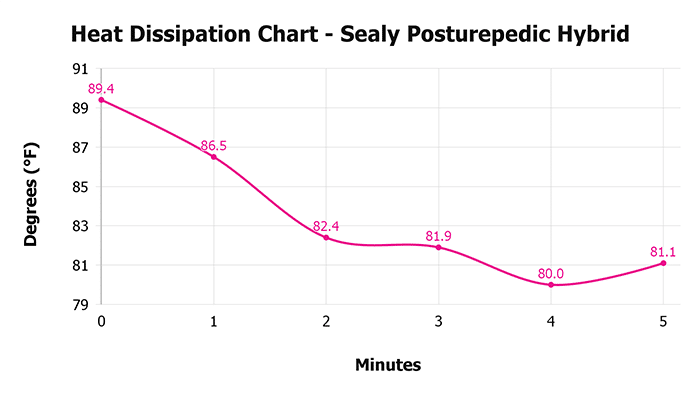
Notably, heat dissipation was better from 0 to 5 minutes, declining by 8.3°, which is 0.7° cooler than average.
Nevertheless, during testing the heating sensation around my body was noticeable. Those who describe themselves as hot or warm sleepers are likely to feel uncomfortably warm on the Sealy Posturepedic Hybrid.
Sinkage Test
The Sealy Posturepedic Hybrid has a very minimal level of sinkage. In our pressure point sinkage tests, we measured a sinkage depth of 1.66”. This is 0.48” less sinkage than the average of 2.14”.
Sinkage Depth
1.66″
Sinkage Feel
Very Minimal
Body Contour
Slight
The level of sinkage is documented in the image below.

The Posturepedic Hybrid creates a “floating on top” of mattress feel, as opposed to sinking down “in’” the mattress. There is a restrained level of body contouring hug.
While the mattress does use 4.0” of foam on top, those foams don’t significantly wrap around the body.
Motion Transfer Test
The Sealy Posturepedic Hybrid has a moderate level of motion transfer. In our tests, we measured a total acceleration range of 11.15 m/s². This is 27% more motion than the average of 8.78 m/s².
Accel. Range
11.15 m/s²
Motion Duration
0.78 seconds
While the 4.0” foam comfort layer helps to mitigate some level of motion, the firmer feel and coil unit still generate a sizable level of motion.
The level of motion transfer is also documented in the video below.
In our motion transfer chart, which visualizes our accelerometer data, we see the highest motion peaks from 0 to 0.21 seconds. In addition, there is a smaller secondary spike from 0.56 to 0.70 seconds before returning to near-zero levels of motion at 0.78 seconds.
Motion Transfer Over Time
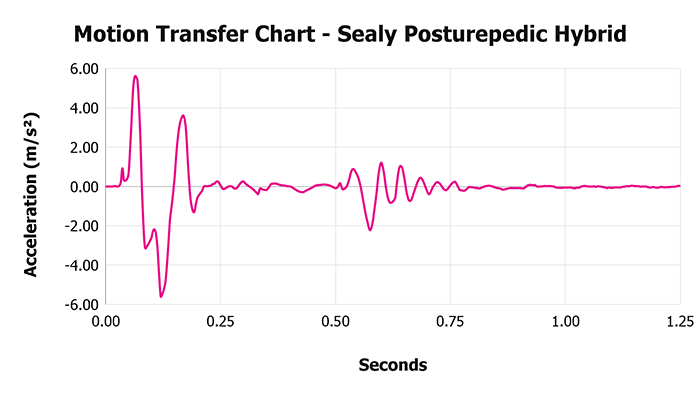
Mattresses with the lowest motion transfer can disperse all energy within 0.3 seconds. Needless to say, the Posturepedic is far from that mark. Its higher-than-average motion transfer spikes earn the Sealy Posturepedic Hybrid a spot in the bottom 29% of all mattresses we’ve tested to date for motion transfer.
Response Test
The Sealy Posturepedic Hybrid has an extremely fast material response. In our tests, we measured a mostly recovered response time of 0.2 seconds and a fully recovered response time of 0.3 seconds.
Mostly Recovered
0.2 sec.
Complete Recovery
0.3 sec.
The level of responsiveness is documented in the video below.
These measurements are tied with several other mattresses for the fastest we’ve tested to date. The Posturepedic Hybrid springs back to shape effectively instantly. The fast response ensures sleepers will never feel stuck and makes the mattress easy to move around on.
Bounce Test
The Sealy Posturepedic Hybrid has a high level of bounce. In our tests, we measured a total bounce height of 9.60”. This is just 0.06” more bounce than the average of 9.54”.
Max. Depth
4.87″
Max. Rebound
4.73″
Total Bounce
9.60″
Max. Sinkage Depth

Max Bounce Height
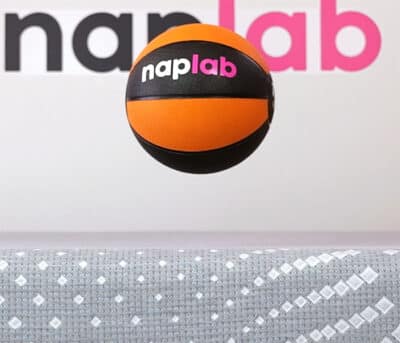
The level of bounce is also documented in the video below.
Ideally, I like to see bounce in the 8-12” range, as it creates enough bounce for ease of movement and improved sex performance, while not being so extremely high so as to create motion transfer issues.
At 9.60” the Posturepedic Hybrid is right in the sweet spot. I expect most sleepers will find this level of bounce to be acceptably high enough to benefit sex and ease of movement.
Edge Support Test
The Sealy Posturepedic Hybrid has excellent edge support for both sitting and lying.
Max. Sinkage
3.75″
Lying Support
Excellent
Reinforced Edge
Yes
In our sitting edge support tests, we measured a sitting sinkage compression of 3.75”. This is 0.28” less sitting sinkage than the average of 4.03”.
The level of edge support while seated is documented in the images below.
Sitting, 140 lbs.

Sitting, 200 lbs.

Ideally, I want to see 4.0” or less, and the Posturepedic Hybrid easily hit that mark.
Lying edge support was equally as good. During our tests, I felt well-supported even when lying directly on the edge of the mattress.
The level of edge support while lying is documented in the images below.
Lying on Edge, 140 lbs.

Lying on Edge, 200 lbs.
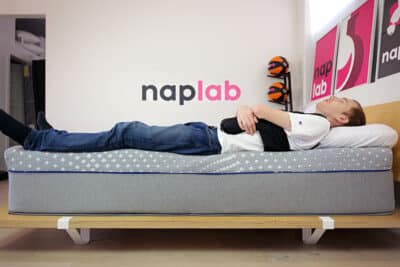
The Posturepedic Hybrid uses reinforced coils at the edge, which seem to have a sizable impact on performance. In addition, we tested the firm version.
Firm mattresses typically have better support in general, but especially at the edge, compared to soft and medium firmness mattresses.
While we found many other performance areas struggling on the Posturepedic Hybrid, edge support was one of the bright spots.
Sex Test
The Sealy Posturepedic Hybrid has good sex performance. On the positive side, Bounce is high at 9.60″, which is 0.09″ more than the average bounce height of 9.51″.
Edge support is excellent as well at 3.75″ of sitting edge sinkage, which is 0.29 less than the average of 4.04″.
Noise is minimal which helps with discretion, as needed.
| Sex Factor | Factor Weight | Score | Rating |
|---|---|---|---|
| Bounce | 65% | 8.5 | High |
| Edge Support | 20% | 9.1 | Excellent |
| Noise | 5% | 10 | Minimal |
| Pressure Relief | 5% | 5.0 | Poor |
| Cooling | 5% | 7.0 | Fair |
On the negative side, pressure relief is poor and cooling performance is only fair.
I would have liked to have seen better performance in these areas, but the reality is that the good bounce and edge support scores really are enough to carry the disadvantages from pressure relief and cooling.

Pressure Relief Test
The Sealy Posturepedic Hybrid has a poor level of pressure relief. During our tests, I felt a moderate to significant level of building pressure points on my body.
Comfort Layer
4.0″
Support Layer
9.0″
These pressure points were felt at several places on my back and shoulders. In my view, the poor pressure relief performance is driven by the mediocre comfort layer.
Technically, the mattress uses a 4.0” comfort layer. However, only 1.5” of those 4.0” are anything approaching a reasonably good quality level.
The 2.0” poly foam core and 0.5” poly foam layer that sits atop the coil unit have a noticeable “crunchiness” to them.
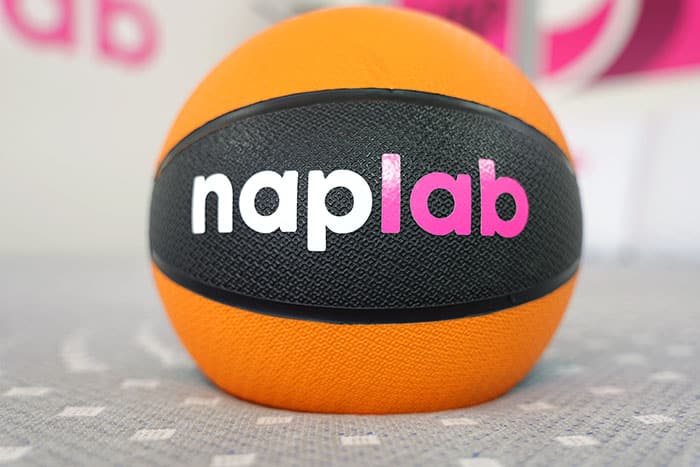
We experienced what appears to be the exact same foams on two of Sealy’s Costco mattresses, the Sealy Posturepedic Plus RidgeCrest II and Sealy Posturepedic Carver. These foams don’t look or feel high quality.
In my view, they are far closer to the type of foam and the quality level you’d expect of a support foam. Suffice to say, it’s not a comfortable foam and it’s not a foam you’d want your body to be coming into direct contact with, in my view.
Off-Gassing Test
Off-gassing on the Sealy Posturepedic Hybrid is mediocre.
Odor right out of the box is strong. It took 11 days to fully off-gas.
Initial Smell Strength
Strong
Off-Gassing Period
11 days
For comparison, the average off-gassing period is 7 days so this is quite a bit longer than average.
Company
Sealy mattresses come with a 90-night trial period and a 10-year warranty. Shipping is free, but if the mattress ends up not working out, returns cost $175.
The average trial period is 178 nights and the average warranty is 13 years (excluding 25% of mattresses that offer lifetime warranties).
| Company Factor | Factor Weight | Score | Data |
|---|---|---|---|
| Returns | 40% | 5.0 | $175 |
| Trial Period | 30% | 6.0 | 90 nights |
| Warranty | 20% | 8.0 | 10 years |
| Shipping | 10% | 10 | $0 |
| Country of Origin | 0% | USA |
How firm is Sealy Posturepedic Hybrid?
The Sealy Posturepedic Hybrid is available in two firmness levels—soft and firm. We personally tested the firm version and found the firmness to be an 8 out of 10 (where 10 is the most firm).

Based on the materials, construction, and quality of the firm, we estimate the soft version of this mattress to be around a 5 out of 10 with a medium feel.

Support & Sleeping Positions
The Sealy Posturepedic Hybrid has a fair level of support. During our tests, I felt that the mattress created sufficient support. However, it also created significant pressure points on my body.
| Support Factor | Data |
|---|---|
| Comfort Layer | 4.0″ |
| Support Layer | 9.0″ |
| Firmness | Medium, and Firm |
| Body Contour | Slight |
| Zoned Support | Yes |
| Reinforced Edge | Yes |
Support is complex in that it’s not enough for a mattress to merely be supportive, it also must be comfortable enough to not create pressure points. A concrete floor is supportive, but won’t comfort the body.

The Posturepedic Hybrid does keep the spine well supported. There is minimal sinkage and more of a floating feeling with the mattress. This makes the mattress better suited to the needs of stomach and back sleepers.
However, the firm feel and minimal sinkage make a poor choice for side sleepers.
All of that said, the pressure relief issues we experienced during our testing should not be discounted.
During our tests, I felt uncomfortable lying on the mattress for any significant period of time.
The limited comfort layer and the quality of the foams in general are the most likely factors inhibiting pressure relief performance.

Notably, we tested the firm version of the mattress. It’s possible the soft version would have better pressure relief. But it’s also possible there would be different support issues impacting that version. Sealy’s material quality and the overall performance of this mattress just don’t inspire much confidence in either version.
Check out the table below to see the sleeper weights and sleeping positions that would be best suited for this mattress.
Firm Version
| Sleeper Weight | Stomach Sleepers | Side Sleepers | Back Sleepers |
|---|---|---|---|
| Under 150 lbs. | Maybe | No | Maybe |
| 150-250 lbs. | Maybe | No | Maybe |
| 250-300 lbs. | Yes | No | Yes |
Soft Version
| Sleeper Weight | Stomach Sleepers | Side Sleepers | Back Sleepers |
|---|---|---|---|
| Under 150 lbs. | Yes | Yes | Yes |
| 150-250 lbs. | Maybe | Yes | Maybe |
| 250-300 lbs. | No | Yes | No |
Design
The Sealy Posturepedic Hybrid is a hybrid mattress with a 13″ thickness. It is available in two firmness options—soft (5 out of 10) or firm (8 out of 10).
| Design Factor | Data |
|---|---|
| Type | Hybrid |
| Thickness | 13.00″ |
| Cover Type | Thin |
| Weight | 91 lbs. |
| Has Handles | No |
| Fiberglass-Free | Yes |
| Ships in a Box | No |
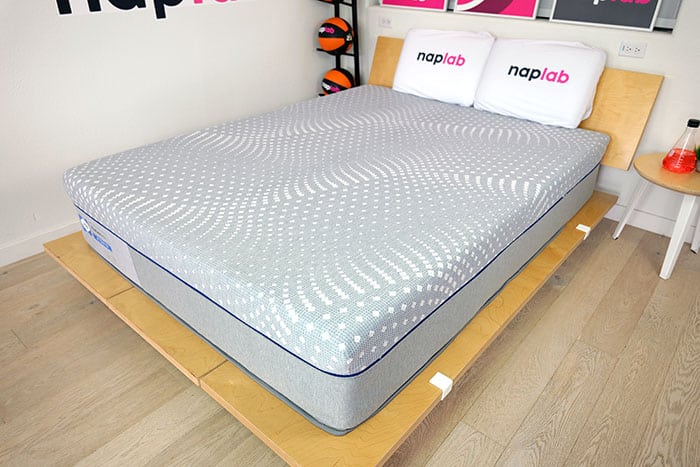
Materials
The hybrid blend of this mattress is created using a mix of foam and an innerspring support unit. From top to bottom, there are five distinct layers, as listed below.
| Layer Type | Thickness | Layer Specs |
|---|---|---|
| Poly Foam | 1.5″ | Not Available |
| Poly Foam | 2.0″ | Not Available |
| Poly Foam | 0.5″ | Not Available |
| Coil Unit | 8.0″ | Not Available |
| Support Foam | 1.0″ | Not Available |
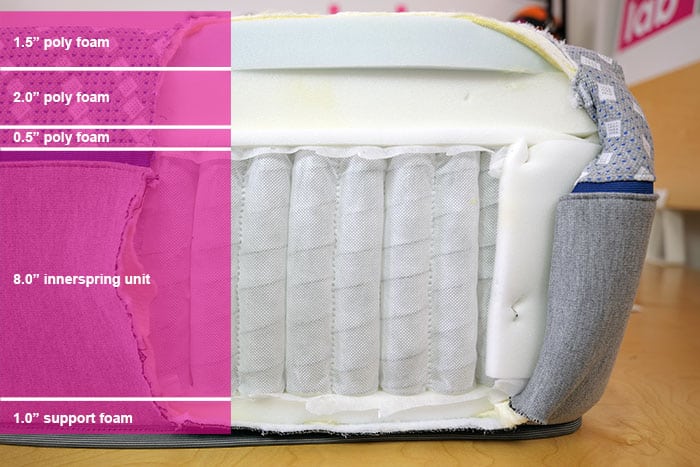
The Law Tag outlines the full breakdown of materials included in this mattress.
- 94% polyurethane foam pad
- 99% polyurethane, 1% liquid gel
- 6% polyester fiber pad
- Innerspring unit
- Made by
- Sealy Mattress, 125 S. 67th Ave. Ste 150, Phoenix, Arizona 85043
- Finished Size
- 60 x 79”
- Weight 91.00 lbs
- Date of manufacturer 01/2024
- Made in USA of imported and domestic components.
The Cover
The cover of the Sealy Posturepedic Hybrid is a thin, knit fabric, that feels breathable and stretchy. According to the manufacturer, it is woven with cooling fibers, but we found the cooling to really be lacking in our cooling tests (shown above).
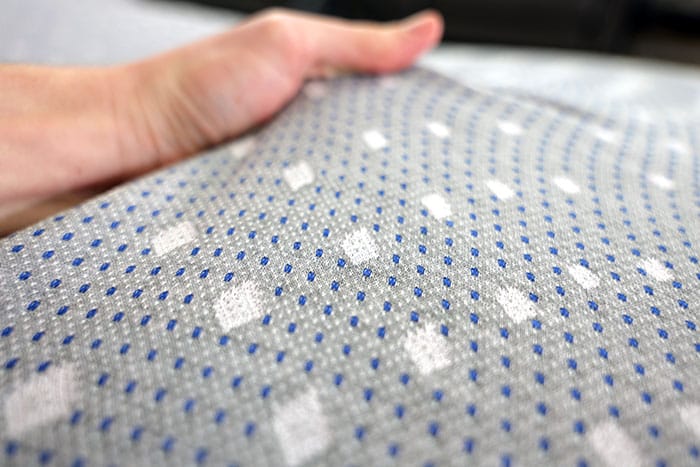
The cover is also treated with a stain-guard technology designed to kill bacteria on the mattress surface and protect against common allergens.
The Comfort Layer
The comfort layer is made up of three foam layers. On the top, there is a 1.5″ poly foam layer followed by a 2.0″ poly foam.
This second layer has the same “crunchiness” to it as the Sealy Posturepedic Plus Ridgecrest that we previously tested. Overall, the quality of both top comfort foams seems low.

The bottom foam in the comfort layer is a 0.5″ poly foam that acts more like a transitional layer as it sits directly above the innerspring unit.
The Support Layer
The support layer is a classic innerspring unit that is 8.0″ thick with reinforced edges for improved edge support.
Motion transfer levels were significantly higher on the Sealy Posturepedic Hybrid compared to many other pocketed coil hybrids we’ve tested.

Product Evolution
The Sealy Posturepedic Hybrid was released in 2022 by Sealy, following the original release of the Posturepedic Plus in 2019.
There have been no major changes to the mattress since its initial launch.

Posturepedic Plus vs. Posturepedic Hybrid
The Original Sealy Posturepedic Plus mattress was first released by Sealy in 2019 as a luxury hybrid. The Posturepedic Hybrid was introduced as a more budget-friendly option for sleepers.
The Posturepedic Plus is available in three firmness levels and three support levels as well. By comparison, the Sealy Posturepedic Hybrid is available in only two firmness levels and one support level.
Other Mattresses to Consider
Not sure if the Sealy Posturepedic Hybrid is the right pick for you? Check out these three other top-rated hybrid mattresses for high-performing alternatives you may want to consider.
For Performance
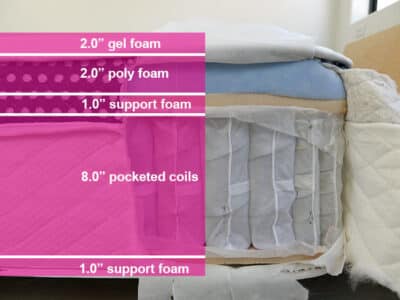
Winkbed Original
#1 Top Rated
The Winkbed Original is our top-scoring hybrid mattress tested to date. It has a 5.0″ comfort layer and outperforms or ties the Posturepedic Hybrid in all 8 performance categories. The price is slightly more than the Sealy, but you’re getting a better mattress overall.
For 14″ Thickness
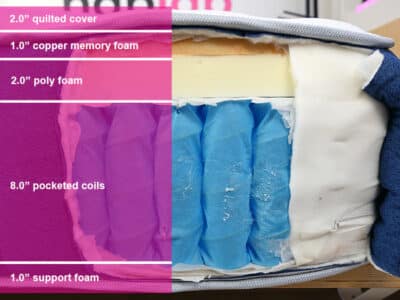
Bear Elite Hybrid
Multi-Firmness Options
The Bear Elite is a 14″ hybrid with a 5″ comfort layer and fantastic performance. This mattress outperforms or ties the Sealy in 7 out of 10 performance categories. Bear Elite is available in soft, medium, and firm versions.
For Budget
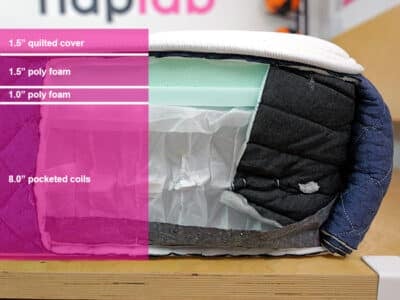
Brooklyn Bedding Signature Hybrid
Fast Response Time
The Brooklyn Bedding Signature Hybrid with a 12″ thickness and an overall performance score that is higher than the Sealy. The price point is actually lower than Sealy as well, only $999 for a queen-size mattress. This is a fantastic pick if you’re looking for good performance, but also want to keep the price in check.
Frequently Asked Questions
Still have questions? Check out some of the top FAQs on the Sealy Posturepedic Hybrid mattress below and get the answers you’re looking for.
Here are the current prices, with any sales or promotions reflected below:
Twin: $1,149
Twin XL: $1,189
Full: $1,199
Queen: $1,249
King: $1,579
Split King: $2,348
Cal. King: $1,579
Split Cal. King: $2,348
*Note: Sales prices are subject to change without notice or warning.
The Sealy Posturepedic Hybrid is available in 2 firmnesses a medium 5 out of 10 (where 10 is the most firm) and a firm 8 out of 10.
Sealy offers a 90-night trial and requires a $175 dollar return fee if you decide you don’t like the mattress.



